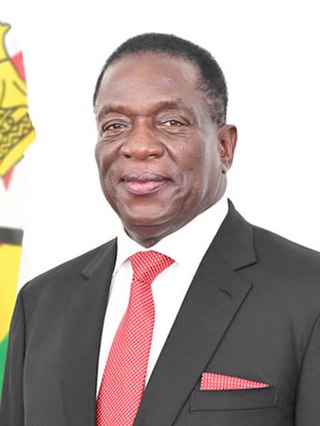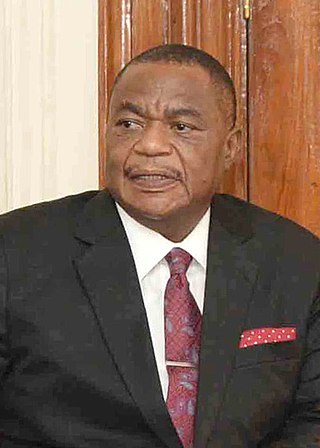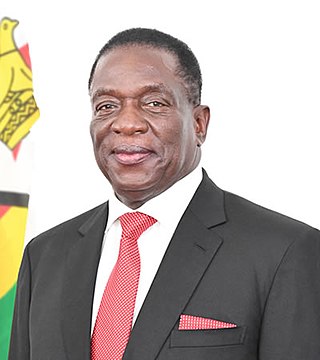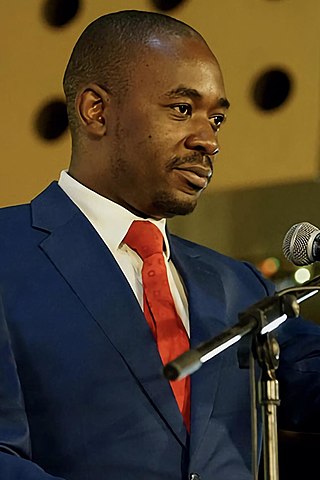
The Gukurahundi was a genocide in Zimbabwe which arose in 1982 until the Unity Accord in 1987. It derives from a Shona-language term which loosely translates to "the early rain which washes away the chaff before the spring rains".

The Zimbabwe African National Union – Patriotic Front (ZANU–PF) is a political organisation which has been the ruling party of Zimbabwe since independence in 1980. The party was led for many years under Robert Mugabe, first as prime minister with the Zimbabwe African National Union (ZANU) and then as president from 1987 after the merger with the Zimbabwe African People's Union (ZAPU) and retaining the name ZANU–PF, until 2017, when he was removed as leader.

Josiah Magama Tongogara was a commander of the ZANLA guerrilla army in Rhodesia. He was the brother of current Zimbabwe President Emmerson Mnangagwa's second wife, Jayne. He attended the Lancaster House conference that led to Zimbabwe's independence and the end of white minority rule.

The Zimbabwe National Army (ZNA) is the primary branch of the Zimbabwe Defence Forces responsible for land-oriented military operations. It is the largest service branch under the Zimbabwean Joint Operations Command (JOC). The modern army has its roots in the Rhodesian Army, which was raised between 1963 and 1964 after the breakup of the Federation of Rhodesia and Nyasaland. A Joint High Command created in March 1980 to oversee integration of the formerly belligerent Rhodesian Security Forces, Zimbabwe African National Liberation Army (ZANLA), and the Zimbabwe People's Revolutionary Army (ZIPRA) officially established the Zimbabwe National Army in late 1980, nearly a year after the end of the Rhodesian Bush War.

Emmerson Dambudzo Mnangagwa is a Zimbabwean politician who has served as President of Zimbabwe since 24 November 2017. A member of ZANU–PF and a longtime ally of former President Robert Mugabe, he held a series of cabinet portfolios and was Mugabe's Vice-President until November 2017, when he was dismissed before coming to power in a coup d'état. He secured his first full term as president in the disputed 2018 general election.
Engelbert Rugeje is a Zimbabwean politician and retired general officer who is the ZANU-PF national political commissar since December 2017. He was the Chief of Staff of the Zimbabwe National Army (ZNA) until 2007. He was a prominent figure in the 2007 Zimbabwean coup d'état attempt. In December 2017 he was promoted from major general to lieutenant general upon retirement and admitted into ZANU-PF.
The Zimbabwean government claimed to have foiled an alleged coup d'état attempt involving almost 400 soldiers and high-ranking members of the military that would have occurred on June 2 or June 15, 2007. The alleged leaders of the coup, all of whom were arrested, were retired army Captain Albert Matapo, Colonel Ben Ncube, Major General Engelbert Rugeje, and Air Vice Marshal Elson Moyo.

The Cabinet of Zimbabwe is the executive body that forms the government of Zimbabwe together with the President of Zimbabwe. The Cabinet is composed of the President, the Vice-Presidents, and ministers appointed by the President. Until 1987, the Cabinet was chaired by the Prime Minister; it is now headed by the President.

Constantino Chiwenga, is a Zimbabwean politician and former army general currently serving, since 2017, as the First Vice-President of Zimbabwe under President Emmerson Mnangagwa. In August 2020, he added the Health Ministry to his portfolio.

The president of Zimbabwe is the head of state of Zimbabwe and head of the executive branch of the government of Zimbabwe. The president chairs the national cabinet and is the chief commanding authority of the Zimbabwe Defence Forces.

General elections were held in Zimbabwe on 30 July 2018 to elect the President and members of both houses of Parliament. Held eight months after the 2017 coup d'état, the election was the first since independence in which former President Robert Mugabe was not a candidate.
The following lists events from the year 2017 in Zimbabwe.

In November 2017, Zimbabwean president Robert Mugabe was removed as president and party leader of ZANU-PF and was replaced by Emmerson Mnangagwa.

Sibusiso Busi Moyo was a Zimbabwean politician and army Lieutenant general. He was noted for announcing the ousting of Robert Mugabe on national television during the 2017 Zimbabwean coup d'état. He went on to serve as Minister of Foreign Affairs and International Trade in the cabinet of Emmerson Mnangagwa from November 2017 until his death.

On 23 June 2018, a grenade exploded at White City Stadium in Bulawayo, Zimbabwe. The blast occurred at a ZANU–PF campaign rally, just after President Emmerson Mnangagwa had finished giving a speech. It was described as an assassination attempt against Mnangagwa, who was unharmed. The bombing resulted in at least 49 injured, including Vice-Presidents Constantino Chiwenga and Kembo Mohadi, and other high-ranking government officials. Two security agents later died of their injuries.

The 2018 Zimbabwe Presidential election petition aimed to overturn the Zimbabwe's presidential elections results which declared Emmerson Dambudzo Mnangagwa as victor. The election was held on Monday July 30.
Jason Zhuwao is a Zimbabwean politician. He is a former ZANU–PF Director for Youth Affairs and son of former Minister of Youth Indigenisation and Economic Empowerment Patrick Zhuwao and nephew to former Zimbabwe President Robert Mugabe. Zhuwao served under his father's ministry youth advisory board and held different government and ZANU PF portfolios.
State House, formerly known as Government House, is the official residence of the President of Zimbabwe and is located in Harare, Zimbabwe. It was previously used by the Administrator of Southern Rhodesia, Governor of Southern Rhodesia and the Governor-General of the Federation of Rhodesia and Nyasaland in addition to being occupied by the internationally unrecognised Rhodesian Officer Administering the Government and later President of Rhodesia. It was constructed in 1910 to a design by Detmar Blow in the Cape Dutch revival style.

State House, formerly called Government House, is a former Government House in Bulawayo, Zimbabwe. It was used by the British South Africa Company during their rule in Rhodesia. It was built by Cecil Rhodes in 1897 as his personal residence. It is now used as the official Bulawayo residence for the President of Zimbabwe.













